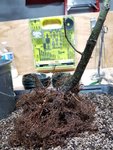<snip> A lot of back and forth on whether to chop or not to chop. My opinion: oaks are meant to be a large bonsai. Not just because of leaf size, but their entire appearance. Some of the most impressive trees I’ve seen in nature are oaks. Massive trunks, old craggy bark, gnarled roots at the surface, towering branches. Just amazing to see.
That being said....... I think going for a chop is the right way to go. You’ve got a couple low branches underneath the kink now and you repotted a little while ago. Your second flush is coming in strong, the tree has been responding well to what’s been thrown at it. A chop sets you back, sure. But you’ve had a lot of good growth since you pulled it from next to the fence last year, and if you are a fan of growing from container exclusively, a chop will do great things for trunk girth. Plus, a fresh start would allow you to make your own kink, just the way you like

.
<snip>
???
Chopping will STOP the development of trunk girth. It will stop it dead in its tracks. The caliper of the trunk will begin to increase once the new branches have grown enough to be supporting more leaf surface area than what was removed by the chop. This may take years. It all depends on when the chop is done. But it is erroneous to believe that a trunk chop helps increase trunk diameter in any way.
What increases trunk diameter is allow the tree to grow. The more leaf surface area supported by a trunk, the more rapidly the diameter of the trunk will increase. In species that back bud easily on older wood, the quickest way to develop trunk diameter is to allow the tree to grow unchecked until the desired trunk diameter is achieved. Trunk chopping slows the development of caliper of the trunk.
Only when a species is reluctant to back bud on old wood is doing a "trunk chop" on a young tree important. In which case, before the trunk reaches the age at which it will no longer back bud, the trunk is chopped to encourage low branches to form. These low branches are maintained (by regular pruning) to keep them from becoming long and leggy. As these branches will not back bud either as they get beyond the critical age. This is when trunk chopping is necessary on a young tree. But note, it slows the development of trunk caliper.
Practical considerations. Sometimes allowing a tree to become 2 or 3 meters tall, 6 to 10 feet tall, in order to increase the caliper or trunk diameter, is simply too difficult to handle. It is leaf surface area supported by a trunk that increases trunk diameter. The trunk can be chopped, to force low branches. The trunk will stop increasing in caliper the minute it is chopped. These low branches can be allowed to extend, perhaps pruned some to increase ramification, and at some point this ramified "bush" will support as much leaf surface area as allowing the trunk to grow unpruned. Once the leaf surface area exceeds the surface are at the time the chop was made, only then will the trunk again begin increasing in caliper.
So unchecked growth is the rapid way to increase trunk caliper. Trunk chopping will halt the increase in trunk caliper, until the new branches support MORE leaf surface area than the previous unchecked growth trunk.
Make sense? Your comments about oak before the "chop" comments are good, on the mark. So you do understand the basics of oak.
Now the question is, do oaks back bud reliably on old wood? I believe the answer for the northern red oak in this thread, the answer is "yes", they do back bud. Therefore chopping the trunk now, at this point would work against the goal of increasing the diameter of the trunk.
When the trunk reaches more than 75% of the desired diameter, it will become time to consider the trunk chop.
The "calculus" changes, when increasing the trunk diameter is not the most important task at hand. But generally, the single trait that separates "sticks in pots" from "real bonsai" is the caliper of the trunk compared to the size of the tree. Trunk caliper is key to developing a bonsai.















